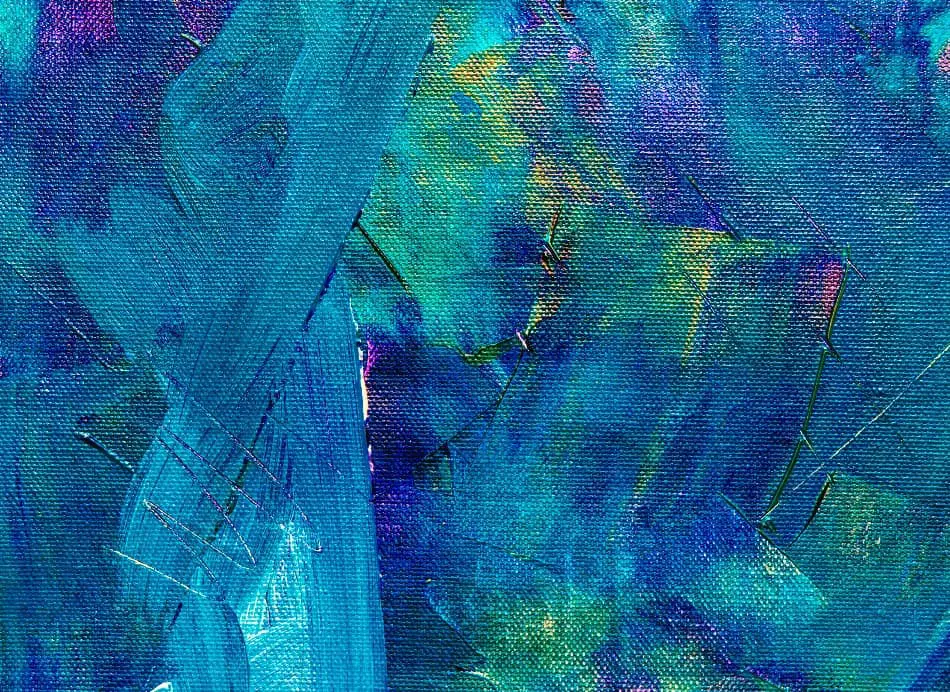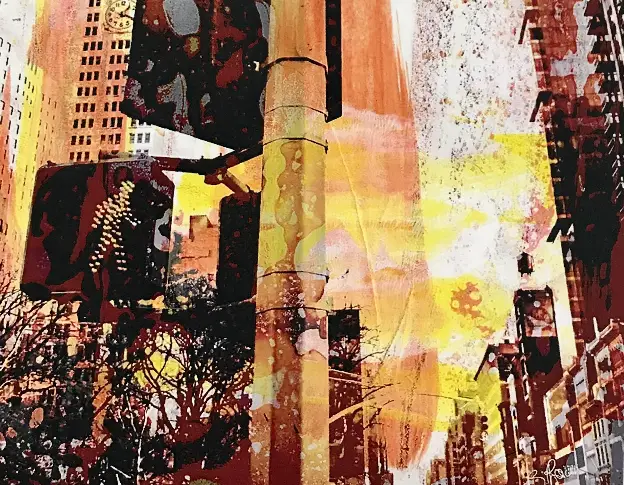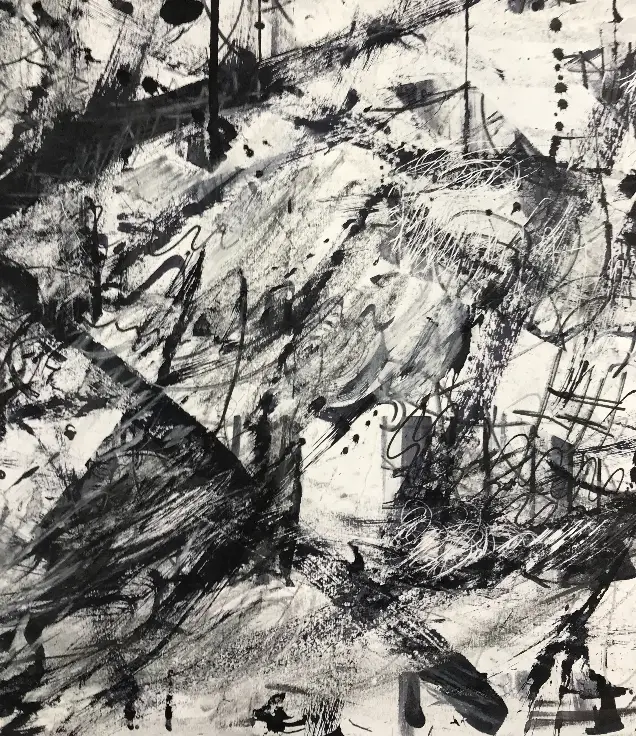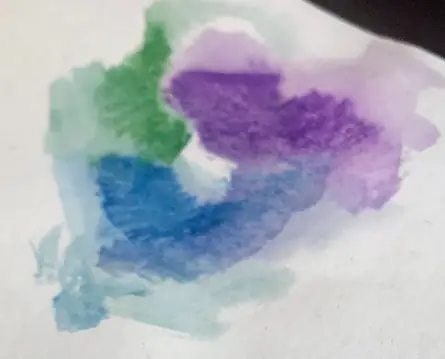Many mixed media artists choose to combine materials, which, when first considered, may not be a logical choice. If you want to extend your understanding of drawing techniques that you can use in combination with acrylic paint. Then drawing on top of them is an excellent way to start. In fact, drawing on top of acrylics colors will provide you with some quite surprising results.
Drawing onto acrylic paint onto can be achieved in several ways. In fact, opaque and graduated acrylic washes are perfect for drawing on top using a combination of charcoal, pen, and white charcoal pencils.
In this post, I will outline several approaches to combining acrylic colors with various drawing materials. We have sourced a variety of artists, crafters, and art supply store managers for advice. Read on to find what techniques they prefer and employ to get the best from different materials.
The techniques suggested and described in this post have been developed by artists who regularly use them in their work. Acrylic and drawing materials have very different qualities, and many varied results can be achieved when you try the combine them in your paintings.
Outlining Acrylic Shapes
The illustrator Jessie Unicorn Moore has tested many different approaches to illustration cupcakes and drawing. In her post, mixed media art ideas, she describes how drawing with pen over dried acrylic can be achieved.
- Drawing over a graduated acrylic wash. One of the main characteristics of acrylic paint is that they are water-soluble but then convert to being resistant when they dry.
- This means that if you are looking to draw with a dark pen over a graduated wash, the lines and shapes will have more of an impact and stand out.
- Drawing with a marker pen. Drawing with a thick pen will also enable you to cover any irregular edges that may result from thick acrylic paint. The trick here is to use a pen with a thick, firm tip as this will make the task a lot more manageable.
- Vibrant Background colors. One of the advantages of painting with acrylics is the color vibrancy you can achieve with them. This can be used to create exciting backdrops to the drawing you want to create.
- Play around with line quality. Jessie Moore likes to play around with the thickness and strength of lines that she draws within her illustrations.
Related Recent Post:
- Can You Use Acrylic Paint on Regular Paper?
- Is Graphite Paper Reusable?
- The Best Papers For Oil Pastels With Examples
- Can You Draw With Crayons On Canvas
The Advantages of Sealing an Acrylic Painting
According to acrylics pouring. ‘Acrylic paints can dry somewhat matte and dull and often look disappointing when compared to how they shine when they are wet.'
To resolve this issue, it is a good idea to seal your acrylic color once they have dried. If you want the colors in your work to have more of an impact, this is definitely worth considering.
Drawing Shapes on Acrylic Painting
The artist Lisa Clough offers a video demonstrating her ideas of drawing onto the paint. Lachri Fine Art uses white pencils as a means to draw upon and outline the shapes in her acrylic paintings.
- White charcoal pencils excellent for drawing intense highlights that work well ontop toned paper. Lacks to dust of a chalk pencil. Sharpener using a craft knife as they have a tendency to break in a conventional pencil sharpener.
- Tracing paper rolls are ideal if you want to produce larger scale canvases. Paper rolls also have the added advantage of being able to be cut to the size you wish to, which minimizes wastage.
Tracing paper to initial drawing the basic outlines of her composition using a white charcoal pencil. This enables her to create an accurate proportional drawing.
Lacchri Fine Art also suggests drawing with a white pencil to bring any new shapes onto the paint's surface once it has dried.
These techniques allow the artist to develop her acrylic paintings in a methodical and organized manner.
Advantages of Drawing onto a Dry Surface
If you aim to draw onto an acrylic canvas, it is best to ensure that the surface is dry. As drawing onto damp paint will not work. The artist Robert Burridge produces nonrepresentational acrylic painting onto which he likes to use a combination of the dry drawing medium. ‘Enjoys bringing the energy of drawing into painting.'
When drawing with Charcoal, Robert Burridge applies a mixture of different charcoal varieties in his mixed media acrylic pieces. The primary being willow charcoal stick.
Once the willow stick has been applied over the surface of the acrylic painting. Charcoal can then be mingled onto the surface of the canvas utilizing your fingers.
Drawing intuitively to highlight the edges of areas of color. This creates depth and gives the appearance of a mixed media piece as opposed to traditional acrylic painting.
Graphite Pencils can also be utilized over the top of the canvas. Identify areas of color or particular features in the image. Again here, Burridge exercises and intuitive mark-making techniques to intensify the surface of the acrylic paint.
Drawing On Acrylic Paint
Your first acrylic painting you'll discover how to draw onto the surface of acrylic paint, you'll be opening the door for an exciting new range of possibilities with your art. Combining more than one type of artistic medium produces what is known as mixed media art.
Mixed media art gives you the ability to combine different mediums so you can take advantage of their strengths by combining them in new ways. While the first rule in art is no rules, you should take this within reason. It would be best if you didn't do certain things simply due to the incompatibility of using certain materials in specific ways.
For example, you'd never want to paint with acrylics over oil paint because the painting won't adhere, and it will end up cracking and peeling. Could you still try it? Sure, maybe you want your paint to crack and peel. If that's the look that you're going for, then great.
If not, you need to pay attention to using materials in ways that won't cause problems. Drawing on top of acrylic painting can produce incredible results, but it has to be done the right way if you want your art to last.
How to Draw With Acrylic Paint
What's the first thing you think of when you think about paint acrylics? Probably painting, right? Yes, acrylic paint is most often used to paint, but it can also use for drawing. When drawing on top of acrylic paint, you may have trouble getting whatever you are drawing with to adhere to it.
Acrylic paint dries to a hard film, it's essentially acrylic plastic once dry, and the slick surface doesn't offer a lot of tooth, making a drawing on top of it inherently tricky. But, guess what adheres better than anything else to acrylic paint?
If you guessed acrylic paint, then you guessed correctly. You can put layer upon layer of acrylic paint on top of one another, and as long as you aren't doing anything outrageous, you should have zero problems with the paint adhering.
The point is that if you want to draw on top of acrylic paint, why not use acrylic paint? You could use a brush with diluted paint and treat it like ink, but that's very close to the painting, and it's going to be hard to create a drawing effect in this way. What about using acrylic paint markers?
There are a variety of acrylic paint markers on the market today that gives you the ability to use acrylic paint like you would any other marker! If you want to draw with acrylic paint, acrylic paint markers are the way to go.
Charcoal on Canvas
When using charcoal on canvas, you have a few options. Charcoal can be used directly on a primed canvas to create superb drawings, and if you add water to the mix, painting as well.
Charcoal is also a popular choice amongst painters for sketching out the preliminary designs for their paintings. But what about adding charcoal on top of paint acrylics? Can this be done?
It can, but anyone that works with charcoal will tell you that if you don't have something for the charcoal to grip, it's going to end up turning into a smudgy mess.
One potential solution you should consider is using clear gesso on top of your painting before drawing with charcoal. Clear gesso is slightly rough, which is perfect for charcoal, and since it's clear, your underpainting will still be showing.
Acrylic and Colored Pencils
Can you use colored pencil over acrylic paint? You can, but you have to be careful. When you use acrylic paint on canvas, you'll probably end up using it more like oil paint. That is, you'll use it in thick layers.
When worked in, thick layers of acrylic paint form a thick plastic film over the surface, which is not the best surface for drawing with wildly colored pencil. You can use a thin layer of acrylic gesso over your painting before using colored pencils on it, but there is a more straightforward solution.
Instead of using your acrylic paints like you would use oil paint, why not dilute them and paint on a porous surface, mimicking the effects of watercolor?
When diluted sufficiently, acrylic paint behaves very similarly to watercolor. Not only does it look like watercolor, but when used on a porous surface such as watercolor paper, it feels like watercolor as well.
This is important because thinned-out acrylic paint on paper will leave enough of the tooth from the paper surface exposed to allow colored pencils to adhere to it.
How Do You Write on Top of Acrylic Paint?
What do you do if you've decided on the missing component of your masterpiece? Should you produce some writing on top of it? If you're working with acrylic paint, then you don't panic.
You can write on top of graduated acrylic washes using a variety of mediums, so all you need to worry about is choosing the suitable medium and application method.
If you're using any dry media on top of acrylic paint, you'll probably need to prime the surface using clear gesso or clear pastel ground.
The good news is that if you spend a little time experimenting, you should be able to find a material and application method that will allow you to write on top of paint acrylics.
Can You Draw with Pencil Over Acrylic Paint?
Drawing with graphite on top of acrylic paint can be tricky, but it can also be fantastic if you manage to pull it off.
The first step is to decide whether you want to draw on top of a thick layer of acrylic paint or if you want to draw on top of a thin wash of paint.
If you want to draw on a thin wash, then make sure that you are working on some paper or other porous material, and make sure that you think the paint out so that it goes on like watercolor.
If you take this approach, drawing directly on the painting should work fine. What if you want to draw on top of thicker paint? In that case, apply clear gesso or clear pastel ground before you start drawing.
Can you Draw on Paint?
Can you draw on paint? Yes. Should you draw on thin paint? If that's the look you want, then by all means, yes! But, make sure that you use your experience, training, and common sense when you take this approach.
Use materials that work well together, and prepare the surface of your painting if necessary. Always remember, when mixing different mediums, there is going to be a period of trial and error, so try not to be too hard on yourself if something does.
Drawing on Oil Paints?
After exploring drawing on top of acrylic paint, you may be tempted to try doing the same thing with oil paint. If this is something that you're considering, there are only two ways this will work.
Every other attempt you make will end up frustrating you and ruining your painting. You have to remember that oil paint doesn't dry. It cures. Curing takes time. When used in thin washes, oil paint can take hours to be touch dry.
When used as a thicker paint, it can take over a week for oil paint to be touch dry. Touch dry doesn't mean that the painting is dry. It simply means enough skin on the surface to apply a fresh layer of paint.
If you try to use anything besides oil paint to do this, you'll end up with problems. Since oil paint isn't fully cured for many months, anything you put on the surface of an oil painting that hasn't cured will crack and peel.
So, what are the two times you can draw on top of an oil painting? First, you can wait six months or longer to ensure that the paint has cured enough to have something put over it.
That takes a lot of patience, and you're still guessing. The oil paint could still be a little wet, which could end up causing problems. Imagine waiting six months for something to dry so you could finish it, only to find out that you should have waited a little bit longer.
The other option for drawing on top of oil paint is to use oil paint bars. Please don't mistake these with oil pastels. While similar in appearance, they are quite different in application. Oil pastels never dry.
Oil paint bars are oil paint in a bar form ideal for drawing on top of oil paint. You can wait for the paint to be touch dry. Then, don't worry about the drawing you are about to create adhering since oil paint typically adheres well to other oil paints. Just make sure that you don't use a thick layer of paint before drawing on top of it.
Can you Use Watercolor Pencils on Acrylic Paints?
How about using watercolor pencils on top of acrylic paint? This can be tricky, but it can work out beautifully for you if you take the time to prepare your surface. The first thing that you need to decide is how you will use your watercolor pencil.
If you're going to use them just like regular colored pencils, you can follow the same type of preparation you would use for using colored pencils on top of acrylic paint. But, what if you want to add water to the mix? What if you want to see what watercolor pencils are truly capable of, but you want to do it on top of a layer of acrylic plastic?
Water and plastic do not mix. Plastic repels water, so painting with watercolors or watercolor pencil on top of acrylic is impossible, or is it? If you apply clear watercolor ground to your acrylic painting before using watercolor or watercolor pencil. You can paint on top of it.
Clear watercolor ground creates a surface similar to watercolor paper, giving artists the ability to use watercolor on top of acrylic paint, something that would generally be impossible.
Can You Use Charcoal Pencils on Acrylic Paints
Using charcoal pencils over acrylic paint is a very popular method for working, so it is a proven process that you can replicate. You need to follow the same rules that you would follow when using graphite or colored pencils over acrylic.
You either use a thin wash of acrylic on a porous surface or prepare your surface by using gesso or pastel ground before drawing on it.
While using paper and thin acrylic washes might be more straightforward, it's worth spending a little more time and effort to work on canvas. Charcoal over acrylic on canvas can produce beautiful effects, and when you mix a little water into it, you can create wash effects.
One popular method for using charcoal over acrylic is to tint a canvas and then work with charcoal and white charcoal to render an image. You can also fix your drawing in place with a workable fixative and add acrylic paint back over the top of it as a way to introduce more color back into the image.
What Can You Put on Top of Acrylic Paint?
What can you put on top of acrylic paint? Fortunately, just about anything. Acrylic paint forms a durable, waterproof surface that is ideal for drawing or painting on top of, as long as you understand the rules of how you should be mixing different media.
A very popular material often used over acrylic paint is oil paint. Oil paint dries extremely slowly, but this drying time allows artists to achieve the beautiful blended effects that are next to impossible to do with any other medium.
That's why many artists will block in initial layers of color using acrylics, then go over the acrylic paint using oil paint. Always remember, you can use oils over acrylics, but never try to use acrylics over oil paint.
Additional Materials to Ultize all of these Techniques
- Willow Charcoal is available at amazon. This is a versatile drawing medium that can be quickly used to create drawn sketches of still life, portraits, or figure life drawing. Willow charcoal also has the added advantage of enabling the artist to apply dense areas of value to drawing at a much quicker rate than conventional graphite pencils.
- White Charcoal Pencils are available on Amazon. White charcoal pencils can be purchased at Amazon and have a smoother quality than chalk pencils.
- Graphite Pencils are available on Amazon. Possess different qualities than charcoal, which lends them to the more precise blending of shadows and details in drawings and pencils.
- Graphite Sticks click to visit Amazon. Offer the artist a closer level of control if producing graduated shadows of highly detailed pictures.
Sources:
- Sealing an Acrylic Painting
- https://en.wikipedia.org/wiki/Acrylic_paint
- Wikipedia: Willow Charcoal
- Wikipedia: Graphite
- Artists: Robert Burridge
- Mixed Media ideas:https://www.mybluprint.com/article/mixed-media-art-ideas
- http://www.unicornlove.com/
- Cupcakes: Jessie Olesen Moore
- https://acrylicpouring.com/best-protective-finishes-for-sealing/
- Drawing onto acrylic paintings.
- https://lachri.com/gallery/






